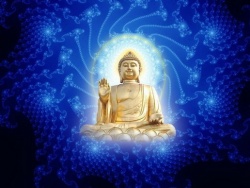The Soul And Prana Or Vital Breath
The Soul is often identified with Prana or vital breath, the energy of action in the form of the element Air, characterised by consciousness, and a vehicle of the spirit or the Soul. In order to study the character of the Soul we have to understand the idea of Prana in the light of all systems of Hindu Philosophy.
Vedanta alone, understanding this twofold nature of the Soul, as characterised by both action and consciousness, examines it from these two points of view, and so is usually divided into two parts, Purva and Uttara Mimamsa, the one dealing with action conceived as a Sacrifice, and the other with God or Soul-consciousness. Sankhya, at the other extreme, regards Prana as physical air, as the energy of action alone, partaking of the energy of food which makes for vitality. Between these lie the three remaining systems of Hindu Philosophy, which regard Prana as partly physical and partly self-conscious in more or less degree and the Upanishads deal with all these points of view in connection with Prana.
Prana in Vedanta: In connection with the idea of Prana according to Vedanta, it is said that Prana, alone is the conscious Self; that the whole Self rests on this breath; that the inner Self is breath; that the Self consists of breath; and air is but the breath of the Self. In this connection we have already explained that Air is the element of action; and with reference to breath it is conceived as fivefold Prana, Apana, Samana, Udana, and Vyana, or up-breathing, down-breathing, back-breathing, out-breathing, and on-breathing.
Prana in Yoga: Yoga examines the idea of Prana in the light of Buddhi, symbolized as the Sun; and so we are told that the breath in the mouth and the Sun are the same; that the breath is identified with the Sun; and that the Sun that shines is the same as breath.
Prana in the Vaisesika: The Vaisesika examines Prana in the light of the Mind; and so we are told that the Self consists of the Mind, and that the Mind is fastened to breath.
Prana in Nyaya: The Nyaya deals with Prana in the light of Purushic Ether or the senses of knowledge; and so it is said that Ether is supported by breath, and the senses themselves are called Pranas or breaths. Then we are told of the celebrated quarrel between the senses on the one hand, and Prana or breath on the other, and it is seen that all of them depend on Prana for their existence.
Prana in the Sankhya: The Sankhya examines Prana in the light of the Prakrtic energy of the Heart, identified with Prakti and Food. Hence it should examine Prana as the energy of the senses of action, and associated with Food both making for physical action in life.
Corresponding to this Prana is shown to be the energy of the senses of action as well as of knowledge in its great quarrel with the senses, and we are told that the origin of breath (Prana) is food, and that breath comes from Water or Prakrti. Again, as the physical body corresponds to Prakrti in each living being, breath is said to be the essence of the body and the sap of the limbs, and it is upheld by food. Then we are told that Food and Breath are two gods associated together; that food is swallowed by breath; and that whatever is eaten, is eaten by breath alone, and it is in breath that it rests.

